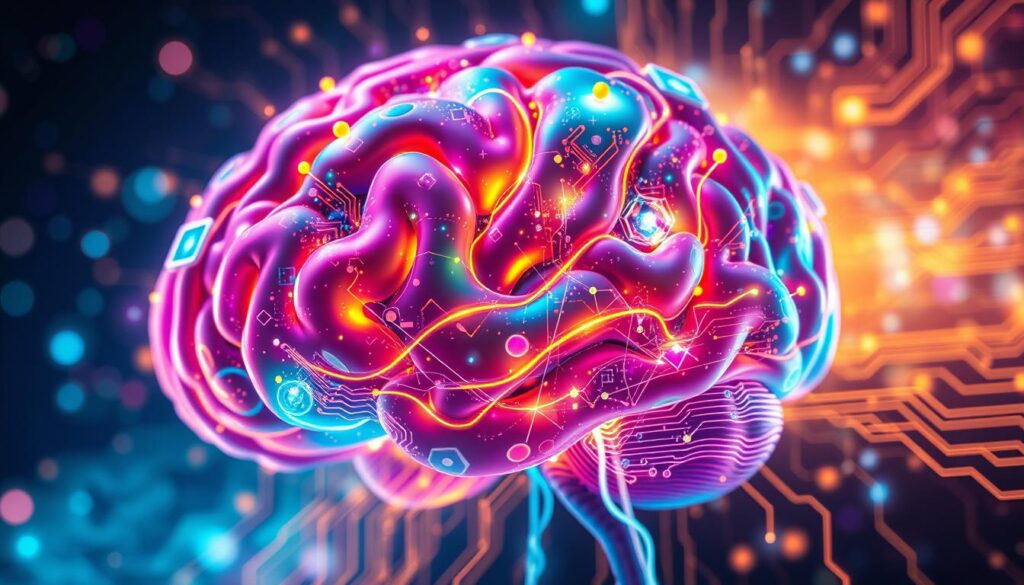“Innovation distinguishes between a leader and a follower.” – Steve Jobs. This statement highlights the importance of tools like ChatGPT in creative writing. As writers aim to create standout content in a rapidly changing digital world, mastering ChatGPT becomes crucial. It allows individuals to streamline their writing and produce unique content that feels original.
ChatGPT serves as a dynamic platform for content creation, enabling users to create custom ChatGPTs for various writing styles. It can analyze up to 50,000 words at once on GPT-4 models, drawing from vast datasets1. However, the success of creative writing with ChatGPT depends on the quality of prompts. Specific instructions are key to ensuring the generated text is original and reflects the writer’s voice2.
This article will provide practical strategies for guiding ChatGPT to produce unique content while keeping your personal touch. It focuses on effective prompting, understanding AI capabilities, and leveraging user preferences. This will unlock the potential to create engaging narratives.
Key Takeaways
- Custom ChatGPTs can be created for various writing styles, enhancing uniqueness.
- Providing detailed prompts is crucial for quality output from ChatGPT.
- Using AI can reduce writing time by up to 75% compared to traditional methods.
- Stories and emotions enrich AI-generated text, making it more relatable.
- Testing different approaches helps refine AI responses for better creativity.
- Consistency in branding elevates the connection with your audience.
Understanding ChatGPT’s Capabilities
ChatGPT is a cutting-edge text-based machine learning model, designed to mimic human responses. It operates through four stages: the spark, the blueprint, the craft, and the polish. Each stage comes with its own set of challenges and opportunities for growth. In the spark phase, writers often face writer’s block. ChatGPT can help by offering topic suggestions, keyword prompts, synonyms, and brainstorming ideas to get started3.
How ChatGPT Generates Text
The core of how ChatGPT generates text is its ability to analyze vast datasets and recognize patterns from past interactions. In the craft phase, it’s vital to provide specific style instructions to match the writer’s voice. ChatGPT can create content in various styles, voices, and samples, catering to different needs. It can get close to mimicking a user’s writing style, reaching about 80% to 90% similarity4.
The Role of Prompting in Text Generation
Effective prompting is key to generating high-quality and unique text. Crafting detailed prompts helps ChatGPT produce responses that better match user expectations. In the blueprint phase, ChatGPT aids in organizing thoughts through mind mapping and outlining. This makes the transition from ideas to structured content smoother. Users should steer clear of open-ended questions, as they may not yield precise results. Instead, using targeted prompts leads to a more productive interaction with the AI, improving content generation3.
Crafting Effective Prompts

Creating effective prompts is crucial for working with ChatGPT to achieve desired outcomes. Specificity is key to success in these interactions. Users should provide clear, detailed requests to avoid generic responses. The importance of context-rich, purpose-driven prompts is paramount for productive interactions with conversational AI tools like ChatGPT5.
Initiating prompts with action-oriented words leads to more specific and actionable responses. This shows how prompt structure impacts the quality of the output.
Importance of Specificity in Prompts
When crafting prompts for ChatGPT, including elements like tone, structure, and specific requirements is essential. This detail enhances the utility of the responses from AI models. The granularity of input queries directly influences the quality of the output6.
Effective ChatGPT prompts often require practice and refinement. This transforms prompt creation into both an art and a science5.
Examples of Unique Prompts for ChatGPT
Unique prompts for ChatGPT can lead to distinctive outputs. For example, asking the AI to explain a complex topic within a specific word limit or style is effective. Requesting a summary of climate change impacts on agriculture in no more than 300 words sharpens the focus of the response.
This approach aids in managing length and can enhance the creativity level of responses. By specifying complexity, such as targeting a high school or Ph.D. audience7, users can maximize their interactions with ChatGPT. This improves the overall effectiveness of their queries.
Leveraging ChatGPT’s Memory
ChatGPT’s memory function greatly enhances user interactions by keeping contextual information across sessions. This feature offers a more personalized experience, changing how users interact with AI. It’s accessible for free or through a subscription, making it valuable in applications like journaling.
Utilizing Contextual Information
Contextual information is key for effective dialogue with ChatGPT. Its memory feature allows the AI to recall user preferences and past interactions, boosting personalization8. This tailored approach ensures ChatGPT’s responses better resonate with users. For example, when journaling about mental health and personal growth, users can share their feelings. They then receive thoughtful prompts, making the experience engaging and relevant910.
Benefits of Providing Background Knowledge
Providing background knowledge for ChatGPT improves interactions. By sharing relevant context, like personal goals or experiences, users can help the AI create more fitting content. ChatGPT’s reflection prompts, such as writing letters to future selves, enhance the journaling experience9. This not only encourages introspection but also strengthens users’ connections with their aspirations and self-discovery10.
Exploring Different Formats

Understanding the strength of various formats in ChatGPT empowers users to create diverse content. The ability to request lists, articles, or stories boosts content creation’s flexibility and innovation. These formats meet specific needs and highlight ChatGPT’s versatility.
Requesting Lists, Articles, or Stories
ChatGPT users can tap into different formats for their benefit. For example, a bulleted list for a recipe simplifies the information, making it easier to follow. On the other hand, a narrative story offers a more engaging and immersive experience. These formats ensure the content’s context and intent are fully met, enhancing user engagement11.
How Format Influences Output Uniqueness
The chosen format significantly influences how information is presented and the output’s uniqueness. Markdown responses are more casual, while HTML responses are structured for professional documents. By specifying the format, users can create content that enhances their projects. This focus on the right format leads to clear and valuable outputs1213.
Asking for Varied Perspectives
In the world of writing, getting unique views from ChatGPT can greatly boost creativity and content depth. By asking specific questions and framing them to encourage diverse responses, we open up to new insights and perspectives. This method prompts the AI to explore different angles, leading to more captivating content.
Framing Questions to Encourage Diverse Outputs
To get varied responses, use open-ended questions that push ChatGPT to think beyond the usual. Encouraging the AI to consider different viewpoints not only enriches the conversation but also brings forth a wider range of ideas. It’s crucial to remember that the quality of your prompts directly affects the depth of ChatGPT’s output14. Without well-crafted questions, the responses might be vague and lack variety15.
Techniques for Eliciting Unique Views
Using methods that highlight various viewpoints can significantly enhance ChatGPT’s creative potential. For instance, adopting different personas or perspectives from diverse backgrounds prompts the model to create content that’s not only unique but also representative of a broader range of experiences15. These techniques help tailor content to specific audiences and goals, ensuring it resonates well with readers. They also aid in crafting compelling narratives, organizing thoughts into clear expressions while celebrating diverse outputs with ChatGPT.
Iterative Interactions with ChatGPT

Engaging in an iterative interaction with ChatGPT is crucial for enhancing response quality. By consistently refining ChatGPT responses through follow-up questions, users can significantly improve output quality. This iterative process allows for greater specificity and fosters deeper engagement with the AI’s capabilities.
Refining Responses through Follow-up Questions
Refining ChatGPT responses involves a methodical exchange where users provide detailed feedback to guide the AI. This back-and-forth communication enables users to clarify their needs, which in turn helps refine the information generated. Each cycle of questioning contributes to an increasingly tailored output, demonstrating how productive dialogue enhances the overall interaction.
How Feedback Shapes Future Outputs
Feedback in ChatGPT outputs plays a crucial role in the system’s learning curve. The iterative interaction not only polishes responses but also allows ChatGPT to adapt based on user input. Over time, this results in more coherent and relevant output, showcasing the profound impact of iterative engagement on AI performance.
Experimenting with Tone and Style

When working with ChatGPT, exploring tone and style is key to creating content that resonates. The ability to request different writing styles in ChatGPT makes the text more unique. Writers can choose from various tones, such as formal, conversational, and humorous, to boost engagement16. With 22 tone options like authoritative, emotional, and persuasive, users can customize the output to meet their needs17.
Requesting Different Writing Styles
ChatGPT provides a range of writing styles, with 19 options like academic, narrative, poetic, and technical16. This variety allows for experimentation with tone, helping creators find the most engaging combinations. Adjusting the style in ChatGPT encourages creativity while ensuring the content reflects the brand’s identity.
The Impact of Tone on Perceived Uniqueness
The impact of tone on uniqueness is significant. A well-chosen tone can dramatically change how readers view a piece of writing. For effective communication, it’s crucial to consider the intended tone during prompting. Tailoring the tone to the content’s purpose enhances clarity and effectiveness, making it more noticeable in a crowded market18.
Incorporating User Preferences

Understanding user preferences for ChatGPT is crucial for optimal content generation. By clearly specifying the audience and purpose, users guide ChatGPT’s responses. This personalization transforms generic responses into valuable content tailored for the targeted audience with ChatGPT.
Specifying Audience and Purpose
Identifying the intended audience informs ChatGPT about the appropriate tone, language, and complexity. Whether the audience is industry professionals or casual readers, this clarity affects the communication style and relevance. By defining these parameters, users can tailor the interaction, leading to responses that resonate deeply with the audience’s expectations and interests1920.
Tailoring Content to Fit Needs
ChatGPT’s adaptability allows users to customize prompts to meet specific preferences. By refining these inputs, users can encourage a focused approach to content generation. This enhances the overall effectiveness of the output. For diverse applications, from legal research to creative writing, understanding how to leverage Custom Instructions ensures responses meet particular requirements. This makes the tool invaluable in various professional settings1921.
Using AI Collaboration

The synergy between human creativity and AI-generated ideas opens up new avenues for content creation. By integrating AI tools like ChatGPT into their workflow, users can tap into its capabilities to boost their creative endeavors. These tools are crafted to aid in brainstorming, story development, and outlining, leading to more vibrant and captivating stories. The chat interface facilitates smooth interactions and collaborations, easing the workload and enhancing productivity22.
Combining Human Creativity with AI Suggestions
The blend of human ingenuity and ChatGPT’s prowess creates a distinctive synergy in content creation. Writers can inject their personal touch while AI swiftly offers structural and conceptual ideas. This dialogue-driven approach refines the output, resulting in a remarkable fusion of creativity23. It allows creators to retain control over the narrative while leveraging AI’s speed and efficiency in text generation24.
Ways to Enhance Content Uniqueness Through Collaboration
To make content stand out, users must actively shape and refine AI’s suggestions. This hands-on method ensures the final product showcases individual creativity and voice, bridging the gap between human input and AI capabilities. By giving ChatGPT clear instructions on details, formats, and styles, users can craft unique content. This focus on clarity and specificity prompts AI to deliver more personalized results, enriching the creative process and fostering effective collaboration23.
Setting Constraints and Guidelines

Imposing limits on content creation with ChatGPT can spark creativity, compelling users to find new ways to express themselves. By setting clear parameters, individuals often uncover unique paths to convey their ideas. These boundaries can lead to innovative thinking, breaking free from traditional writing norms and resulting in more original content.
How Limitations Foster Creativity
Establishing limits in prompts can lead to more captivating and original content. For example, setting specific themes or angles can prompt the model to generate responses that are more detailed and unique. This narrowing of possibilities can unveil unexpected ideas, offering fresh perspectives that might not emerge in open-ended scenarios.
Experimenting with Word Counts
Setting precise word counts in writing tasks enhances clarity and conciseness. These limits help writers refine their messages, choosing the most impactful words for their audience. This approach fosters a disciplined style, benefiting both the creator and the model’s output25.
Evaluating the Uniqueness of Responses

In the realm of evaluating uniqueness in ChatGPT, understanding how to assess the output’s originality becomes crucial. Various tools for detecting content originality have emerged to assist users. These tools aim to ensure that the text generated is not only unique but also free from plagiarism. A significant aspect of assessing ChatGPT responses relies on using specific prompts and techniques to discover the most original content possible.
Tools for Detecting Content Originality
Researchers highlight that employing methods such as chain-of-thought prompting can notably enhance ChatGPT’s capabilities. This approach helps not only in generating coherent responses but also in ensuring that those responses stand out distinctly in originality26. Tools designed for this purpose can analyze generated text against vast databases, identifying overlaps and potential sources of similarity, thus detecting content originality effectively.
Criteria for Assessing Output Uniqueness
When assessing ChatGPT responses, certain criteria can be pivotal in determining their uniqueness. Evaluating creativity, originality, and fidelity to prompts allows for a comprehensive analysis of the generated content. Domain experts play a vital role in this process, providing nuanced feedback that helps discern the quality of the outputs more reliably than automated metrics27. By implementing these criteria, users can improve their ability in assessing ChatGPT responses and enhance the quality of their interactions with the model.
Best Practices for Achieving Unique Content

To enhance your output, it’s crucial to follow best practices for ChatGPT content. A structured approach focusing on specificity, memory utilization, and iterative feedback is key. This ensures unique content is achieved.
Summary of Key Strategies
Clear and concise prompts are essential for guiding the AI towards specific goals. Research shows nearly half of users always interact politely with AI, highlighting the need for respectful dialogue in achieving quality responses28. It’s also important to utilize ChatGPT’s memory to maintain context in longer conversations, remembering up to 3,000 words28.
Breaking requests into smaller parts often leads to better writing tones. This method encourages engaging interactions and allows for requesting continuations from the AI when responses are too long28. Exploring various writing styles can produce a range of outputs, from academic essays to corporate memos28. Prompting ChatGPT to adopt specific personas can also lead to unique and captivating results, enhancing content originality.
Common Mistakes to Avoid
It’s important to avoid common mistakes in ChatGPT for optimal use. Ambiguous prompts often result in vague outputs that fail to meet expectations. Refining AI responses through follow-up questions is crucial for improvement. Neglecting this step can severely limit potential enhancements.
Creating content tailored to the intended audience is vital for relevance. However, many users overlook this, resulting in generic content29. Recognizing these pitfalls and following best practices for ChatGPT content can significantly improve your content generation process.
Future of Unique Content Generation with ChatGPT
The AI text generation landscape is on the cusp of a transformative era, driven by groundbreaking advancements in AI technology. These improvements will significantly boost the capabilities of tools like ChatGPT. The tool’s ability to grasp context, sustain longer conversations, and tailor content to user preferences is set to soar. This evolution promises not only quicker content creation but also reshapes the landscape of traditional content creation roles. It will necessitate a surge in positions focused on AI and machine learning to oversee these advanced systems3031.
Advances in AI Text Generation
The growing importance of AI-generated content in sectors like SEO and digital marketing is undeniable. The personalization and customization capabilities of AI tools, such as ChatGPT, are set to have a profound impact. Users can look forward to content that is deeply personalized, reflecting their unique interests and preferences. This trend is crucial for future interactions. Yet, the swift integration of AI content generation tools has also led to a decline in traditional writing jobs. This highlights a significant shift in how content is both created and consumed32.
Predictions for Content Uniqueness in the Future
As AI models advance, the future of unique content generation will likely see significant changes. The increasing reliance on AI for content creation might lead to a shortage of original work. This could prompt a shift towards innovative formats and concepts that incorporate diverse perspectives and expert insights. In this new era, the importance of human touch and rigorous fact-checking will remain paramount. AI tools, despite their advancements, may still find it challenging to fully replicate the complexity of human creativity3132.
FAQ
How can I get ChatGPT to write something unique?
What role does prompting play in text generation with ChatGPT?
Why is specificity important when crafting prompts for ChatGPT?
Can you provide examples of unique prompts for ChatGPT?
How does ChatGPT utilize contextual information during interactions?
What are the benefits of providing background knowledge to ChatGPT?
What types of content can I request from ChatGPT?
How does the format of a request influence the uniqueness of the output?
How can I encourage diverse outputs from ChatGPT?
What techniques can enhance creativity in ChatGPT’s responses?
How can I refine ChatGPT’s responses through follow-up questions?
How does user feedback influence ChatGPT’s outputs?
In what ways can I experiment with tone and style in ChatGPT’s writing?
What impact does tone have on the perceived uniqueness of content?
How do audience and purpose affect ChatGPT’s writing?
How can I enhance content uniqueness through collaboration with ChatGPT?
How do limitations foster creativity with ChatGPT?
What role does experimenting with word counts play in content generation?
What tools can I use to detect the originality of content generated by ChatGPT?
What criteria should I use to assess the uniqueness of ChatGPT’s responses?
What are some best practices for achieving unique content with ChatGPT?
What common mistakes should I avoid when using ChatGPT?
What advances are being made in AI text generation?
What predictions can be made for the future of content uniqueness with ChatGPT?
Source Links
- How to train ChatGPT to write like you | Zapier
- How to Get ChatGPT to Write Like You (Or Better)
- I cracked the code to writing with ChatGPT. Here’s how you can too…
- How to Get ChatGPT to Write Like You
- 215+ ChatGPT Prompts You Can’t Miss To Try Out In 2024
- Effective Prompts for AI: The Essentials – MIT Sloan Teaching & Learning Technologies
- 6 ways to write better ChatGPT prompts – and get the results you want faster
- How to use Memory Effectively in ChatGPT | Mark Hinkle posted on the topic | LinkedIn
- Transforming Self-Care: How I Use ChatGPT for Reflective Journaling
- ChatGPT Gets a Memory: What You Need to Know
- Exploring ChatGPT Output Formats: A Guide to Presenting Information – Fabio Vivas
- Mastering the Art of Formatting ChatGPT’s Responses
- How to Train ChatGPT to write like you – It’s That Lady Dev
- Train ChatGPT To Write Like You In 5 Easy Steps
- How to make ChatGPT write like a human in 7 steps – Intellectual Lead
- How to Train ChatGPT to Write Like You
- Make ChatGPT Write In Your Style, Your Tone: Step-By-Step Guide
- The Top 6 ChatGPT Styles and Tones To Make Your Writing Pop
- Best Custom Instructions for ChatGPT (Ultimate Guide for 2024) – Workflows
- 10 Clever Techniques to Get Unique Content from ChatGPT
- 14 Chat-GPT Prompts for Faster UX Research | Looppanel
- Collaborative Creative Writing with OpenAI’s ChatGPT
- Maximizing Your Collaboration with ChatGPT: Tips and Tricks for Working with Your New Writing Partner
- Turn AI chatbots into better writing partners: a step-by-step guide for the less famous
- The 7 golden rules for generating effective prompts with ChatGPT
- 5 Prompts for Making ChatGPT More Accurate
- Evaluating chatGPT
- How to… use ChatGPT to boost your writing
- A Guide to Crafting Effective Prompts for Diverse Applications
- ChatGPT and the Future of Content Generation
- AI-Generated Content and ChatGPT: A Complete Guide
- The Future of Writing and Content Creation in a Post-ChatGPT World






